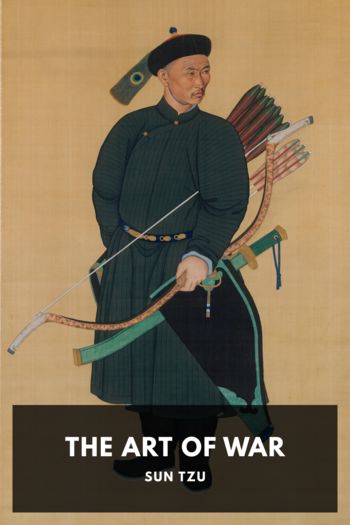The Art of War, Sun Tzu [best english books to read for beginners TXT] 📗

- Author: Sun Tzu
Book online «The Art of War, Sun Tzu [best english books to read for beginners TXT] 📗». Author Sun Tzu
Chêng Yu-hsien is his 遺說 inserts 妙 after 法. I take it that these words conclude the extract from the 軍政 which began at earlier with the words “The Book of Army Management says …” ↩
The heading means literally “The Nine Variations,” but as Sun Tzǔ does not appear to enumerate these, and as, indeed, he has already told us (chapter V, “Indirect tactics, efficiently applied …” through “The direct and the indirect lead on …”) that such deflections from the ordinary course are practically innumerable, we have little option but to follow Wang Hsi, who says that “Nine” stands for an indefinitely large number. “All it means is that in warfare 當極其變 we ought to vary our tactics to the utmost degree … I do not know what Tsʽao Kung makes these Nine Variations out to be [the latter’s note is 變其正得其所用九也], but it has been suggested that they are connected with the Nine Situations”—of chap. XI. This is the view adopted by Chang Yü: see note 406 on 死地 (“In a desperate position …”). The only other alternative is to suppose that something has been lost—a supposition to which the unusual shortness of the chapter lends some weight. ↩
Repeated from chapter VII (“In war, the general receives …”), where it is certainly more in place. It may have been interpolated here merely in order to supply a beginning to the chapter. ↩
For explanation of 圮地, see note 580 on XI. ↩
See XI, “Ground which forms the key …” and “On open ground …” Capt. Calthrop omits 衢地. ↩
絕地 is not one of the Nine Situations as given in the beginning of chap. XI, but occurs later on (chapter XI, “When you leave your own country …” q.v.). We may compare it with 重地 (chapter XI, “When an army has penetrated …”). Chang Yü calls it a 危絕之地, situated across the frontier, in hostile territory. Li Chʽüan says it is “country in which there are no springs or wells, flocks or herds, vegetables or firewood;” Chia Lin, “one of gorges, chasms and precipices, without a road by which to advance.” ↩
See XI, “Ground which is reached …” and “On hemmed-in ground …” Capt. Calthrop has “mountainous and wooded country,” which is a quite inadequate translation of 圍. ↩
See chapter XI (“Ground on which we can only be saved …” and “On hemmed-in ground, resort to stratagem …”) Chang Yü has an important note here, which must be given in full. “From 圮地無舍,” he says, “down to this point, the Nine Variations are presented to us. The reason why only five are given is that the subject is treated en précis (舉其大略也). So in chap. XI, where he discusses the variations of tactics corresponding to the Nine Grounds, Sun Tzǔ mentions only six variations; there again we have an abridgment. [I cannot understand what Chang Yü means by this statement. He can only be referring to the four paragraphs starting at either ‘On dispersive ground …’ or ‘Therefore, on dispersive ground …’ in chap. XI; but in both places all the nine grounds are discussed. Perhaps he is confusing these with the Six 地形, (‘We may distinguish six kinds of terrain …’) of chap. X] All kinds of ground have corresponding military positions, and also a variation of tactics suitable to each (凡地有勢有變). In chap. XI, what we find enumerated first [starting at ‘Ground which can be freely traversed …’] are the situations; afterwards [starting at ‘If the enemy has occupied …’] the corresponding tactics. Now, how can we tell that the 九變 ‘Nine Variations’ are simply the 九地之變 ‘variations of tactics corresponding to the Nine Grounds’? It is said further on [in chapter VIII] that ‘the general who does not understand the nine variations of tactics may be well acquainted with the features of the country, yet he will not be able to turn his knowledge to practical account.’ Again, in chap. XI [here] we read: ‘The different measures adapted to the nine varieties of ground (九地之變) and the expediency of aggressive or defensive tactics must be carefully examined.’ From a consideration of these passages the meaning is made clear. When later on the nine grounds are enumerated, Sun Tzǔ recurs to these nine variations. He wishes here to speak of the Five Advantages [see infra, ‘Ground which forms the key …’], so he begins by setting forth the Nine Variations. These are inseparably connected in practice, and therefore they are dealt with together.” The weak point of this argument is the suggestion that 五事 “five things” can stand as a 大畧, that is, an abstract or abridgment, of nine, when those that are omitted are not less important than those that appear, and when one of the latter is not included amongst the nine at all. ↩
“Especially those leading through narrow defiles,” says Li Chʽüan, “where an ambush is to be feared.” ↩
More





Comments (0)